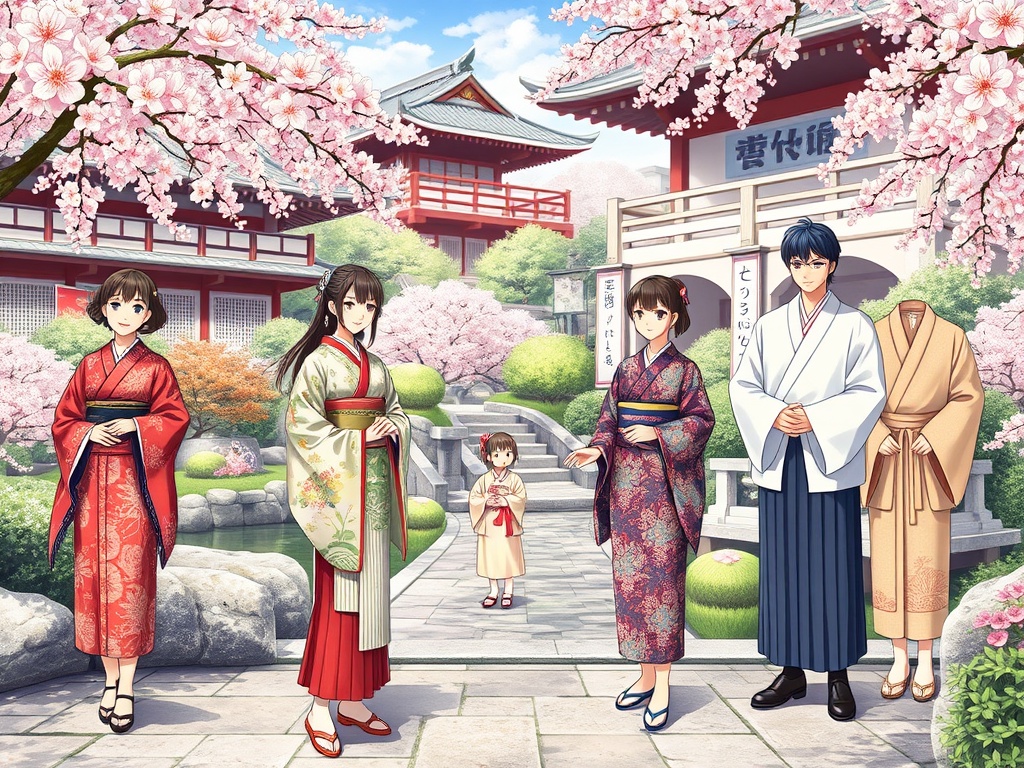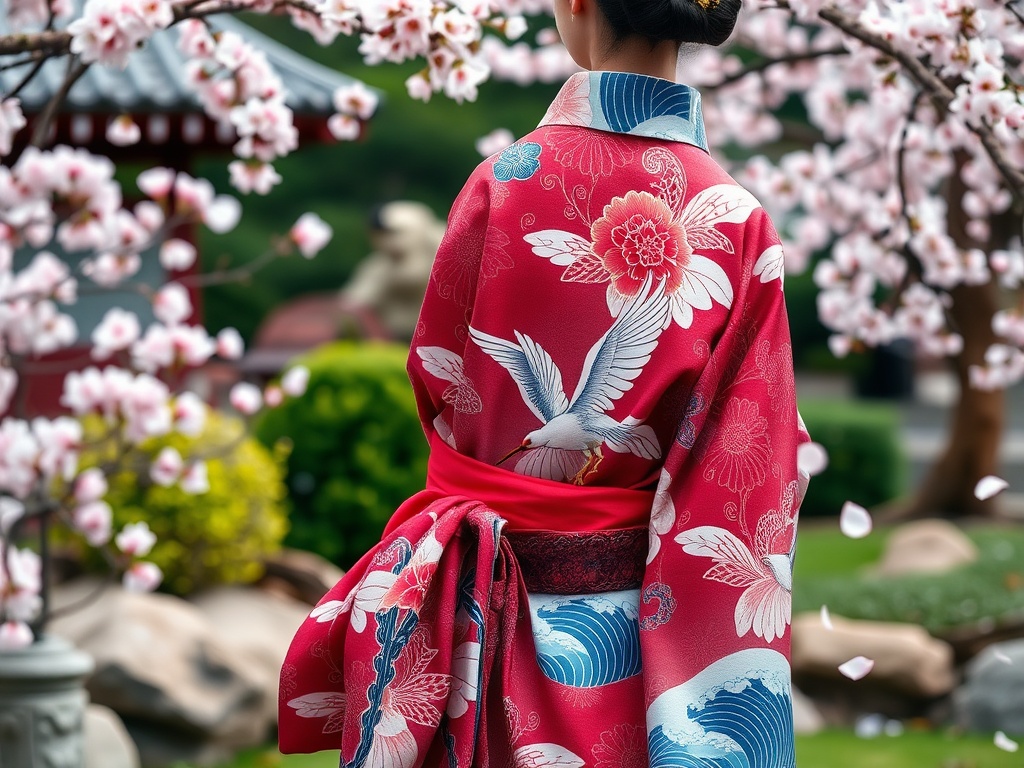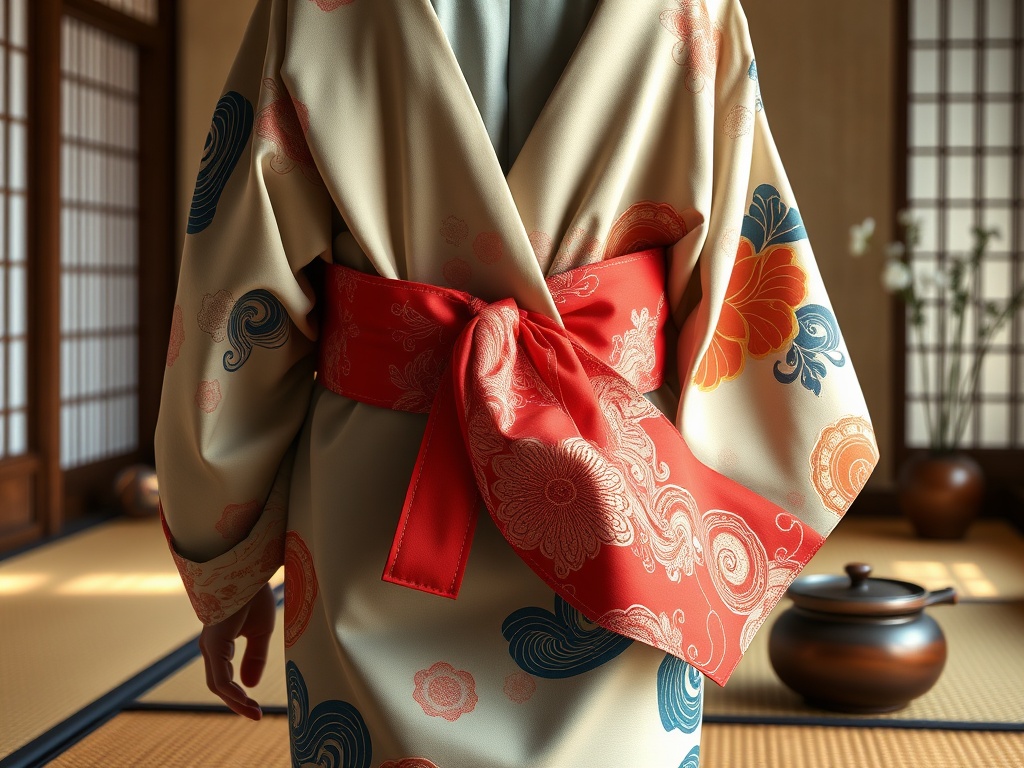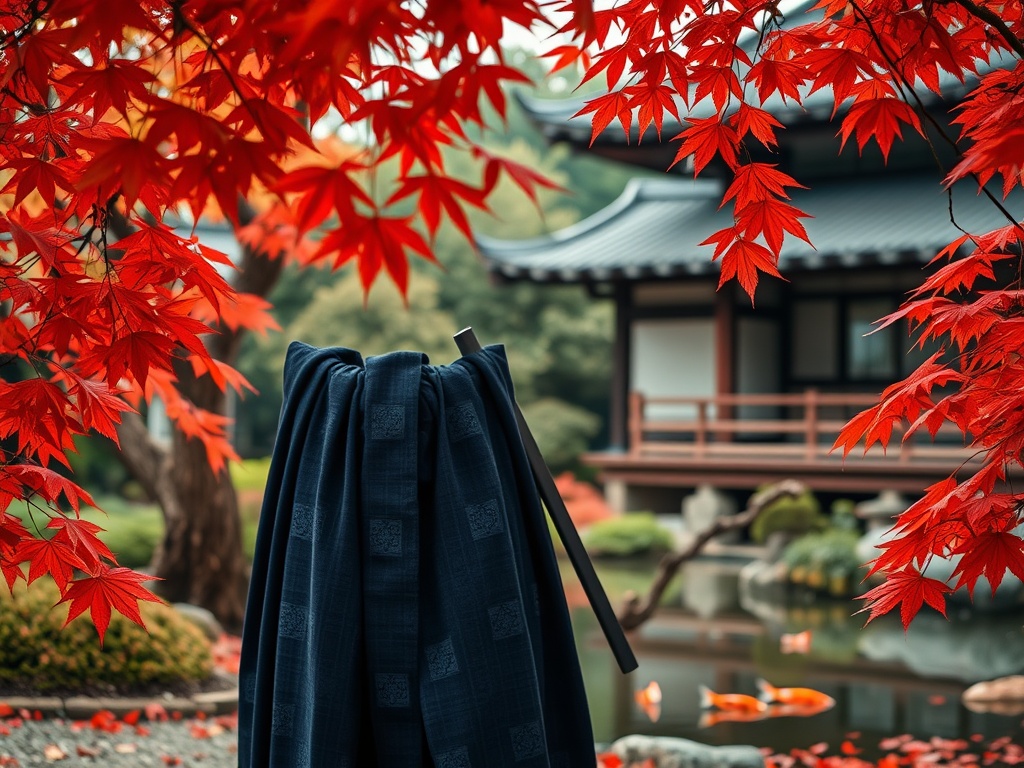Kimono Chronicles: Discover the Symbolism and Elegance
Win a Free Trip to Japan!
Experience cherry blossoms and ancient temples
Japan’s cultural tapestry is rich and vibrant, woven intricately with traditions that date back centuries. Among these traditions, clothing stands out as a living embodiment of history, artistry, and social norms. The kimono, with its flowing elegance and symbolic designs, is more than just a garment; it is a narrative of Japan’s timeless beauty. As you delve into the world of kimonos, prepare to be captivated by their artistic allure and the stories they silently tell.
The kimono is not merely a piece of clothing but a work of art, each stitch and pattern bearing cultural significance. Traditionally crafted from silk, the kimono’s design often reflects the seasons, with cherry blossoms for spring or maple leaves for autumn. The colors and patterns are carefully chosen to convey messages, with motifs like cranes symbolizing longevity and pine trees representing resilience.
While the term ‘kimono’ is often used generically, there are several types that vary based on occasion, age, and even marital status. Here’s a glimpse into some of the most notable styles:
Types of Kimono and Their Uses
- Furisode: The most formal kimono for unmarried women, known for its long sleeves and bright colors, frequently worn at ceremonies like Coming of Age Day.
- Yukata: A casual kimono made from cotton, typically worn during summer festivals or as a bathrobe in onsens.
- Tomesode: A formal kimono for married women, featuring shorter sleeves and often adorned with family crests, worn at weddings and formal events.
- Hakama: While not a kimono, it is often worn over the kimono by men and women during traditional ceremonies like tea ceremonies or martial arts.
Wearing a kimono is an art that requires practice and understanding of etiquette. The left side of the kimono is always wrapped over the right, a practice rooted in tradition and symbolism, as the opposite is reserved for the deceased. The obi, or sash, is tied in elaborate knots, each with its own cultural significance. Learning to wear a kimono properly is a journey into Japanese culture itself.
The Art of Obi: Unraveling the Secrets of Japanese Sashes
In the realm of traditional Japanese attire, the obi stands as a quintessential element, binding the ensemble with grace and elegance. This elaborate sash, often crafted from silk or cotton, is not merely a functional accessory but a profound symbol of Japanese culture and aesthetics. The obi’s history is as rich and diverse as the culture it adorns, making it an essential topic for any traveler seeking to understand Japan’s sartorial heritage.
Each obi tells a story through its color, pattern, and style, serving as a visual language that communicates the wearer’s status, occasion, and even sentiments. For instance, a maru obi, known for its opulent embroidery and heft, is reserved for formal occasions. In contrast, the more subdued nagoya obi is favored for casual wear. The choice of motifs, such as cherry blossoms or geometric designs, further conveys seasonality and personal taste, offering an insight into the wearer’s personality.
The intricate art of tying an obi, known as musubi, is a skill that requires both practice and creativity. Each knot, or obi musubi, carries its own meaning and is chosen based on the occasion and the type of kimono worn. The taiko musubi, resembling a drum shape, is one of the most popular styles for women, while the kainokuchi knot, simple yet elegant, is often used for men. Learning these knots is not just a sartorial skill but a journey into the heart of Japanese culture, offering travelers a deeper connection to the traditions of this fascinating land.
Samurai Style: The Timeless Allure of Hakama Pants
In the realm of traditional Japanese clothing, the Hakama hold a unique place, captivating travelers with their historical charm and elegant drapery. These wide-legged trousers were once the symbol of the samurai, embodying the spirit and discipline of Japan’s noble warriors. Today, they remain a cherished garment, worn during martial arts, tea ceremonies, and other cultural events. As you explore Japan’s rich sartorial heritage, the hakama offers a fascinating glimpse into the country’s storied past.
The roots of the Hakama trace back to Japan’s Heian period, where they evolved from a simple garment to a symbol of rank and status. Originally, the length and style of hakama indicated the wearer’s position within the samurai hierarchy. Over time, they became synonymous with the Bushido code, reflecting the virtues of loyalty, honor, and bravery. For the modern traveler, wearing a hakama is not just a nod to tradition but a step into the footsteps of Japan’s legendary warriors.
While the samurai no longer roam the streets, the Hakama persists as an integral part of Japanese culture. During traditional ceremonies, both men and women don these exquisite pants, pairing them with kimonos to create a harmonious ensemble. Whether attending a tea ceremony or practicing Kendo, the hakama continues to exude elegance and grace. For tourists, experiencing the comfort and fluidity of hakama is a memorable way to connect with Japan’s cultural roots.
For those interested in exploring more about hakama, visiting traditional clothing stores or participating in cultural workshops offers a deeper understanding of their construction and significance. As you walk the streets of Kyoto or roam the gardens of Tokyo, the allure of hakama will be a captivating aspect of your journey through Japan’s timeless elegance.
Beyond the Kimono: Exploring the Versatility of Yukata
When one thinks of traditional Japanese clothing, the mind often conjures the image of the elegant kimono. However, Japan’s sartorial heritage offers a variety of styles, each with its own unique charm and cultural significance. Among them, the yukata stands out for its simplicity and versatility, offering travelers a deeper dive into the everyday beauty of Japanese attire. This lightweight garment, often seen fluttering at summer festivals and onsens, has a story that is as vibrant as its patterns.
The yukata is a casual version of the kimono, traditionally made of cotton or synthetic fabric, making it perfect for Japan’s hot and humid summers. Its origins date back to the Heian period, where it was initially worn by courtiers after bathing. Today, it is commonly worn at summer festivals, fireworks displays, and ryokan (traditional inns). Unlike the formal kimono, the yukata is designed for comfort and ease, reflecting a more relaxed and informal side of Japanese culture. The designs often feature bold and seasonal motifs such as flowers, fireworks, and rivers, adding a splash of color to the vibrant summer nights.
For travelers, donning a yukata provides an intimate connection to Japanese customs. While simpler than a kimono, wearing a yukata still requires attention to traditional etiquette. The left side is always wrapped over the right, symbolizing life, as the reverse is reserved for funerals. The obi, or sash, is tied with a simple knot, often at the back, allowing for ease of movement. Many festivals offer rentals, giving visitors the opportunity to experience this joyful tradition firsthand. Walking through a festival adorned in a yukata, with lanterns illuminating the night, transforms an ordinary evening into an unforgettable cultural immersion.
Beyond its aesthetic appeal, the yukata provides an opportunity for travelers to participate in Japanese traditions. Whether you’re attending a Hanabi (fireworks) festival or relaxing in a steaming onsen, the yukata is your gateway to a truly authentic Japanese experience. For those keen to learn more, workshops and classes are available, teaching the art of wearing and even making a yukata. These sessions offer a hands-on approach to understanding the nuances of this beloved garment, making it a memorable highlight of any trip to Japan.
| Aspect | Kimono | Yukata |
|---|---|---|
| Material | Silk | Cotton |
| Occasion | Formal Events | Casual/Summer Festivals |
| Seasonality | All Year | Summer |
Footwear Fables: The Role of Geta and Zori in Japanese Tradition
As you traverse the vibrant streets of Japan, adorned in traditional attire, an essential yet often overlooked element completes the ensemble—the footwear. In Japanese culture, geta and zori are not just shoes but timeless symbols, each telling its own story of heritage and elegance. Whether clattering down a cobblestone path or gliding quietly through a tatami room, these sandals offer a unique insight into the balance of functionality and beauty that defines Japanese fashion.
Geta, with their distinctively elevated wooden soles, are a striking feature of Japanese footwear. Originally designed to keep feet dry and clean in muddy or rainy conditions, they have evolved into a fashion statement, often paired with casual yukata or even formal kimonos. The rhythmic click-clack of geta on pavements is a sound synonymous with traditional festivals, echoing the steps of history through lively streets. Travelers donning geta will find themselves stepping back in time, embracing a piece of Japan’s rustic charm.
In contrast, zori are more akin to Western flip-flops, crafted from materials like straw, cloth, or even leather for formal occasions. Zori are typically worn with more formal attire, such as the kimono, and are favored for their comfort and understated elegance. Unlike geta, zori are characterized by their flat soles and are often worn with tabi, traditional split-toe socks, adding a layer of sophistication to the ensemble. For travelers, zori offer a seamless blend of comfort and tradition, allowing for effortless exploration of Japan’s cultural landscape.
Understanding the nuances of geta and zori not only enriches your appreciation of Japanese attire but also enhances your travel experience, offering a deeper connection to the cultural tapestries of Japan. Whether you’re attending a festival or visiting a historic site, these traditional sandals invite you to walk with the echoes of Japan’s past, one step at a time.
The Haori Experience: From Function to Fashion in Japanese Jackets
In the realm of traditional Japanese attire, the haori stands out as a versatile garment that seamlessly bridges the gap between function and fashion. Originally designed as a practical overcoat to shield wearers from the elements, the haori has evolved over centuries to become a symbol of style and sophistication. Whether you’re strolling through the serene gardens of Kyoto or exploring the bustling streets of Tokyo, the haori offers a unique glimpse into Japan’s sartorial evolution.
Tracing its origins back to the Sengoku period, the haori was initially worn by samurai to provide warmth and protection over their armor. Its design allowed for ease of movement, making it an ideal choice for warriors on the go. Over time, this jacket found its way into civilian life, becoming a staple in both men’s and women’s wardrobes. The transformation of the haori from a functional piece to a fashion statement reflects Japan’s ability to blend practicality with aesthetic appeal.
In contemporary Japan, the haori is celebrated for its elegance and adaptability, often worn over kimonos for added flair. Its loose silhouette and open front make it a perfect layering piece, suitable for various occasions, from casual outings to formal events. The vibrant colors and intricate patterns of modern haori designs offer a fresh take on traditional Japanese motifs, making them popular among fashion enthusiasts worldwide.
Popular Uses of Haori Today:
- Layering over casual wear: Pair a haori with jeans and a t-shirt for a chic, East-meets-West look.
- Enhancing formal attire: Worn over a kimono, the haori adds a touch of elegance to any formal gathering.
- Cultural events and festivals: Embrace traditional Japanese culture by donning a haori during local celebrations and festivals.
For travelers eager to immerse themselves in Japanese culture, wearing a haori offers a unique and stylish way to experience traditional clothing. Many shops and markets across Japan offer haori for purchase, allowing you to take home a piece of this timeless fashion. Additionally, participating in cultural workshops can provide valuable insights into the history and craftsmanship behind these elegant jackets, enriching your understanding and appreciation of this Japanese fashion staple.



